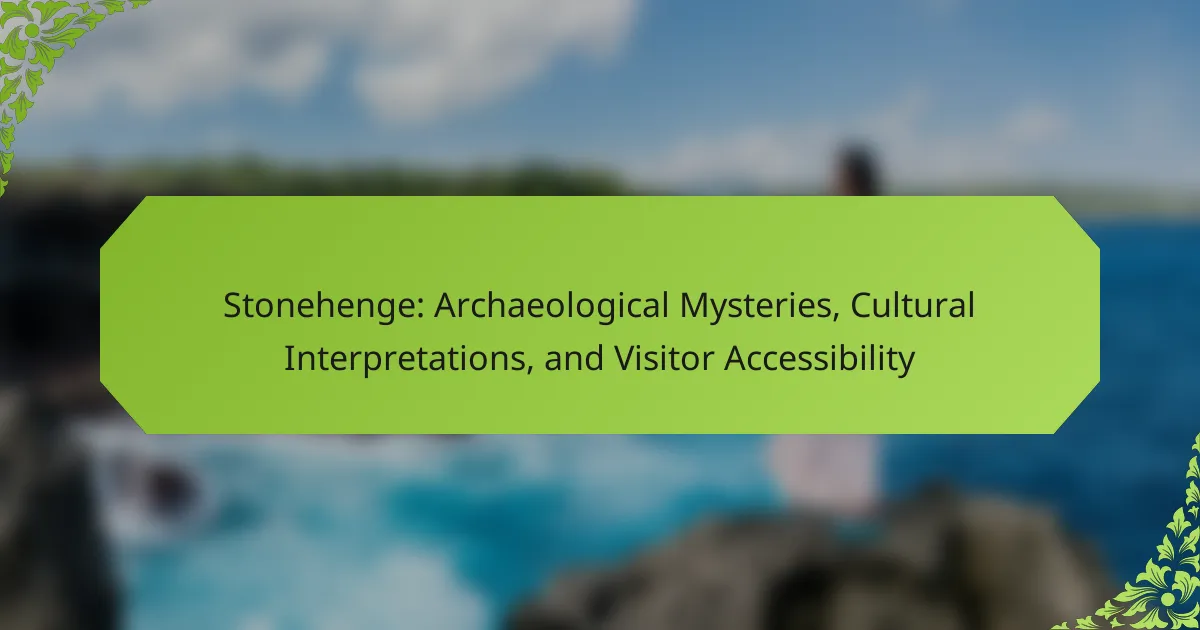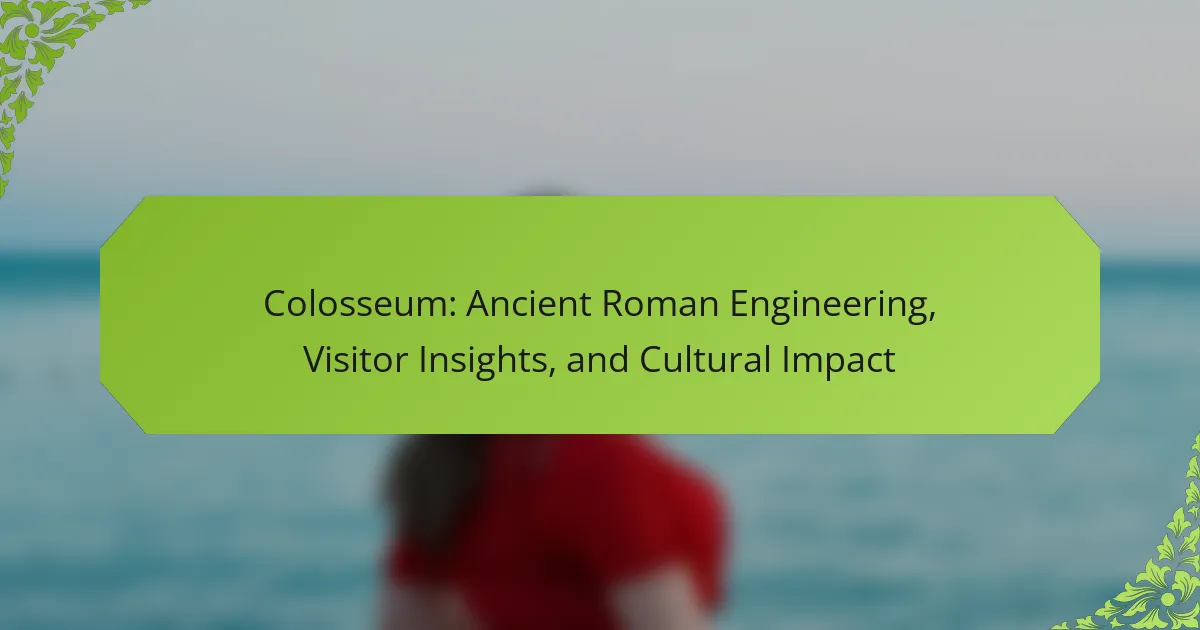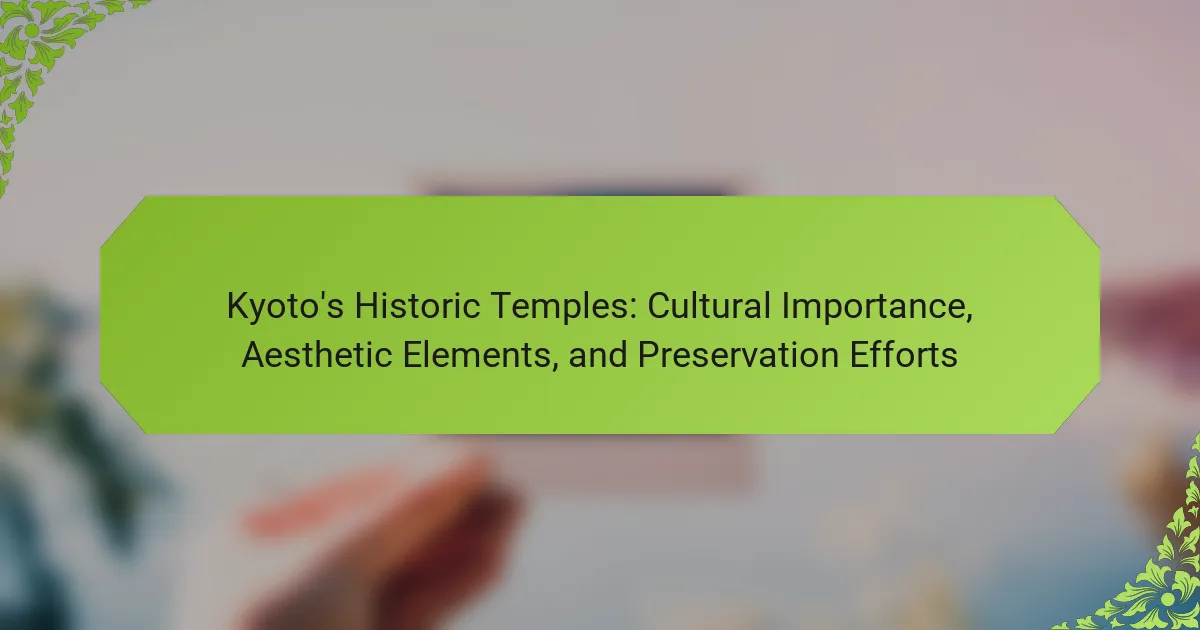Stonehenge captivates visitors with its archaeological mysteries and cultural significance. This article explores the latest insights from advanced research techniques, evolving interpretations of its purpose, and the challenges of visitor accessibility. Discover how ongoing studies enhance our understanding of this iconic site and what improvements can be made for a better visitor experience.
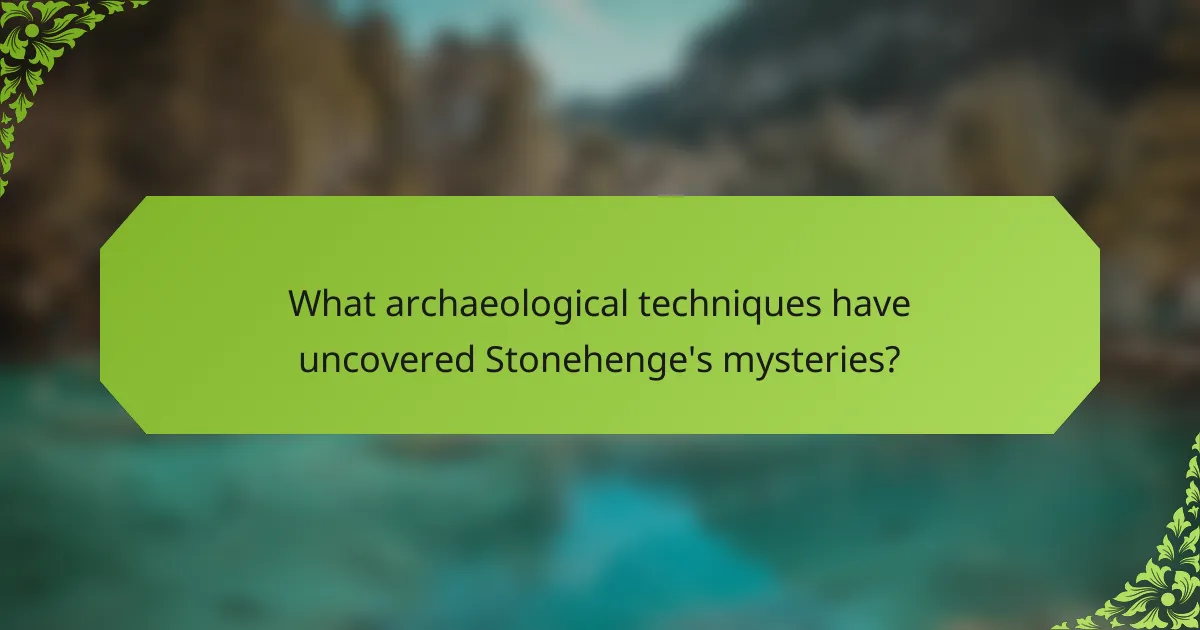
What archaeological techniques have uncovered Stonehenge’s mysteries?
Archaeological techniques such as ground-penetrating radar and excavation have revealed insights into Stonehenge’s construction and purpose. Ground-penetrating radar detects subsurface features without excavation. Excavation has uncovered burial sites and artifacts, providing evidence of ritualistic practices. Radiocarbon dating of organic materials has established timelines for construction phases. These methods collectively enhance understanding of the monument’s cultural significance and historical context.
How have radiocarbon dating methods contributed to understanding its timeline?
Radiocarbon dating has significantly enhanced the understanding of Stonehenge’s timeline. This method has provided precise dates for the construction phases, revealing that the site was built between 3000 BCE and 2000 BCE. The dating of organic materials found at the site, such as charcoal and human remains, has allowed archaeologists to establish a clearer sequence of events. For example, the earliest phase involved the construction of the earthworks, followed by the erection of the stone circle. These findings have contributed to the broader narrative of Neolithic Britain, illustrating cultural and technological advancements during that era.
What role do geophysical surveys play in revealing hidden structures?
Geophysical surveys play a crucial role in revealing hidden structures at Stonehenge. These surveys use techniques like ground-penetrating radar and magnetometry to detect subsurface features without excavation.
By identifying anomalies in the geological patterns, researchers can uncover previously unknown structures, such as burial sites or other ceremonial features. This non-invasive approach preserves the integrity of the site while providing valuable insights into its historical context.
Recent surveys have revealed potential structures surrounding Stonehenge, suggesting a more complex landscape than previously understood. This finding enhances our understanding of the cultural significance of Stonehenge and its surrounding area.
Which excavation findings have changed perceptions of Stonehenge’s purpose?
Recent excavation findings have revealed that Stonehenge served multiple purposes, including as a burial site and a ceremonial center. Discoveries of human remains and artifacts indicate its role in ancient rituals. Archaeologists found evidence of feasting and gatherings, suggesting a communal aspect to its use. These insights challenge previous notions of Stonehenge as solely an astronomical observatory. The integration of various functions highlights its significance in Neolithic society.
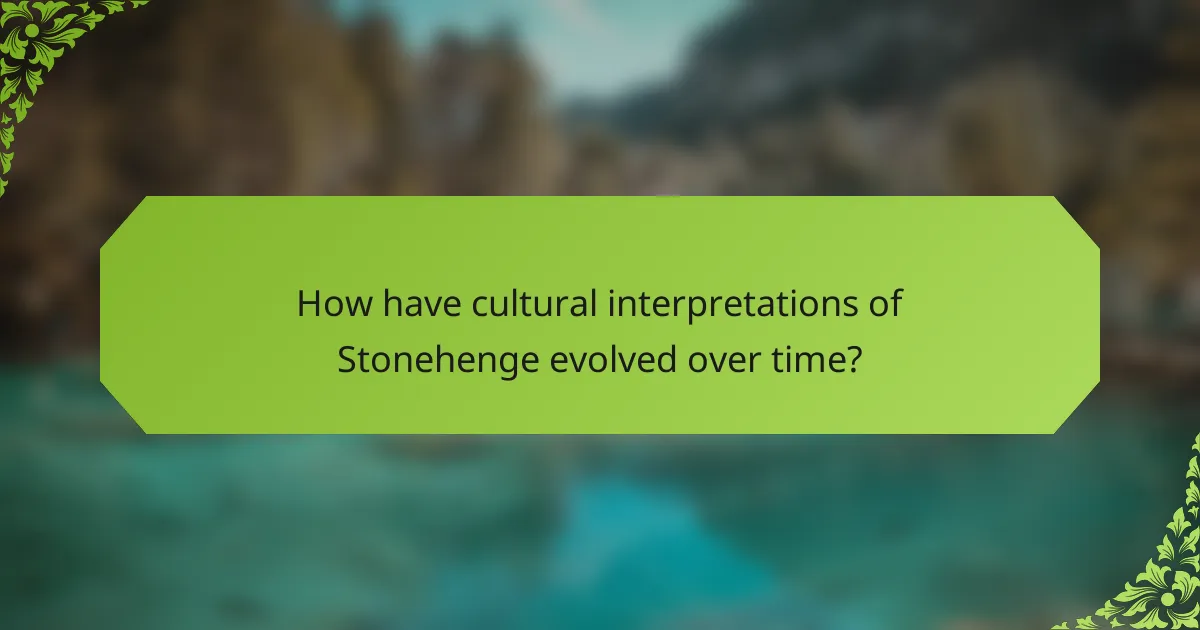
How have cultural interpretations of Stonehenge evolved over time?
Cultural interpretations of Stonehenge have evolved significantly, reflecting changes in societal beliefs and values. Initially viewed as a prehistoric temple or burial site, interpretations shifted to include theories of astronomy and ancient rituals. In modern times, Stonehenge symbolizes unity and spirituality, attracting diverse visitors. This transformation highlights the site’s adaptability to contemporary cultural narratives.
What significance does Stonehenge hold in modern spirituality and rituals?
Stonehenge holds significant value in modern spirituality and rituals as a symbol of connection to ancient traditions. Many contemporary practices involve honoring the solstices and equinoxes at this site, reflecting its historical role in astronomical alignments. Spiritual groups often gather to celebrate these events, emphasizing themes of renewal and harmony with nature. The site’s enigmatic history contributes to its allure, drawing visitors seeking spiritual experiences. Additionally, rituals at Stonehenge promote community and a sense of belonging among participants.
How do local legends and folklore shape its cultural narrative?
Local legends and folklore significantly shape the cultural narrative of Stonehenge. These stories enhance the site’s mystical allure and connect visitors to ancient beliefs. For instance, local tales often attribute the monument’s construction to giants or magical beings, reinforcing its enigmatic presence. Such narratives influence tourism, as visitors seek to experience the legends firsthand, deepening their cultural engagement. Additionally, folklore fosters community identity, as residents share these stories, preserving their heritage while promoting Stonehenge as a symbol of local pride.
Which artistic representations have emerged from Stonehenge’s imagery?
Artistic representations inspired by Stonehenge include paintings, sculptures, photography, and digital art. These works often explore themes of mystery, spirituality, and ancient culture. Notable examples include impressionist interpretations and modern installations that reflect the site’s historical significance. Artists like John Constable and contemporary creators have contributed to this diverse artistic legacy, showcasing Stonehenge’s enduring influence on creativity.
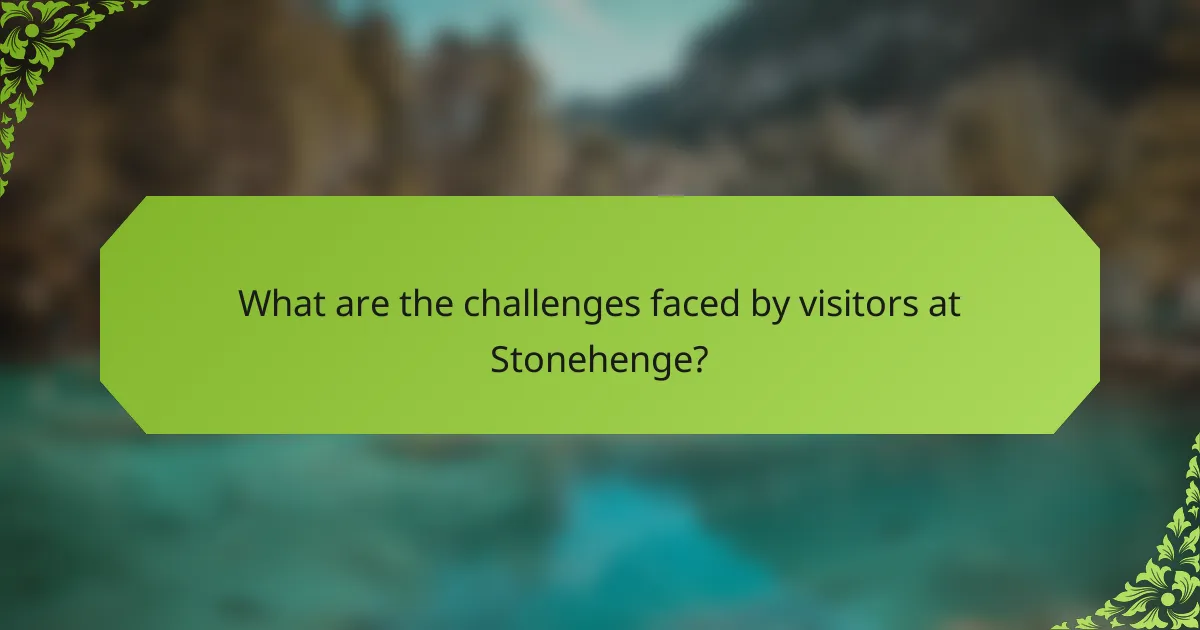
What are the challenges faced by visitors at Stonehenge?
Visitors at Stonehenge face challenges related to accessibility, crowds, and weather conditions. Accessibility is limited for those with mobility issues due to uneven terrain. High visitor numbers can lead to congestion, detracting from the experience. Additionally, the unpredictable weather can affect comfort and enjoyment during visits.
How does visitor accessibility vary across different demographics?
Visitor accessibility at Stonehenge varies significantly across different demographics. Factors such as age, mobility, and sensory needs influence the experience. For instance, wheelchair access is available, yet some paths may be uneven. Families with young children benefit from designated areas, while elderly visitors may require additional seating. Cultural interpretations also affect accessibility perceptions, as some groups prioritize different aspects of the site. Overall, enhancing visitor accessibility remains essential to ensure inclusivity for all demographics.
What measures are in place to enhance visitor experience?
Stonehenge enhances visitor experience through guided tours, interactive exhibits, and accessibility features. These measures provide educational insights and ensure inclusivity for all visitors. The site offers audio guides in multiple languages, enhancing understanding of its archaeological significance. Additionally, designated pathways and facilities accommodate visitors with mobility challenges, promoting a welcoming atmosphere.
Which seasonal events attract the highest visitor numbers?
Stonehenge attracts the highest visitor numbers during the summer solstice, winter solstice, and the equinoxes. These seasonal events draw thousands of visitors eager to experience the site’s historical significance and cultural interpretations. The summer solstice, in particular, sees the largest crowds, with estimates reaching over 20,000 attendees celebrating the longest day of the year. During these events, visitors enjoy access to unique rituals and gatherings, enhancing their understanding of Stonehenge’s archaeological mysteries.
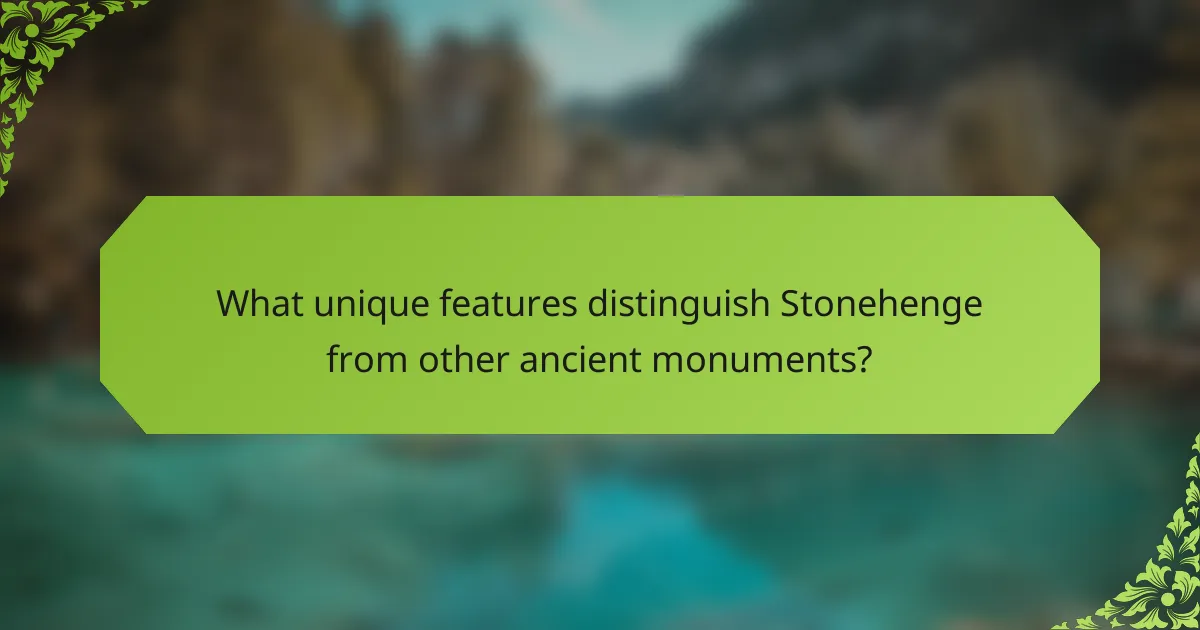
What unique features distinguish Stonehenge from other ancient monuments?
Stonehenge is distinguished by its massive stone circle, precise astronomical alignments, and unique construction techniques. Unlike other ancient monuments, it features lintels set atop vertical stones, creating a trilithon structure. The site also exhibits a rare combination of cultural significance and engineering prowess, reflecting complex rituals and community organization. Additionally, its ongoing archaeological studies continue to reveal new insights, making it a dynamic subject of interest.
How does the alignment of Stonehenge with celestial events set it apart?
The alignment of Stonehenge with celestial events distinguishes it as an ancient astronomical observatory. This alignment marks significant solar and lunar events, such as solstices and equinoxes, showcasing its role in prehistoric timekeeping and ritual practices. The unique architectural design, featuring large sarsen stones, enhances its celestial significance. Visitors can experience this alignment during specific times of the year, reinforcing its cultural and historical importance.
What rare artifacts have been discovered in the vicinity of Stonehenge?
Rare artifacts discovered near Stonehenge include ceremonial objects and personal items. Notable finds are a unique Neolithic dagger, a bronze age shield, and various burial goods. These items provide insight into the cultural practices and social structures of ancient communities. Each artifact contributes to understanding the historical significance of Stonehenge as a ceremonial site.
Which architectural techniques were uniquely employed in its construction?
Stonehenge utilized unique architectural techniques like post-and-lintel construction and precise astronomical alignment. The massive sarsen stones were transported from distant quarries, showcasing advanced planning and social organization. The circular layout reflects significant cultural symbolism, likely related to rituals and celestial events.

How does Stonehenge’s preservation impact archaeological research?
Stonehenge’s preservation significantly enhances archaeological research by ensuring the integrity of the site. It allows for continuous study of its construction methods, cultural significance, and historical context. Well-preserved structures provide clearer insights into ancient societies and their practices. Preservation efforts also facilitate advanced technologies, such as non-invasive surveying, which can reveal hidden features without disrupting the site. As a result, researchers can uncover new findings that contribute to our understanding of human history.
What conservation strategies are implemented to protect the site?
Stonehenge conservation strategies include site management, visitor education, and habitat preservation. These measures aim to protect the archaeological integrity and cultural significance of the site while ensuring public access. Regular monitoring and research contribute to understanding environmental impacts. Collaboration with local communities enhances conservation efforts by promoting awareness and stewardship.
How do climate change factors threaten the integrity of Stonehenge?
Climate change factors threaten the integrity of Stonehenge through rising sea levels, increased erosion, and temperature fluctuations. These elements compromise the site’s structural stability and preservation. For instance, heavier rainfall leads to soil erosion around the monument, while temperature changes can affect the stone’s integrity. Furthermore, increased tourism due to climate-related awareness can strain existing visitor infrastructure, impacting both accessibility and conservation efforts.
What role do community initiatives play in Stonehenge’s ongoing preservation?
Community initiatives play a crucial role in Stonehenge’s preservation by fostering local engagement and funding conservation efforts. These initiatives, such as educational programs and volunteer activities, enhance public awareness and support for the site’s maintenance. Collaborative projects often involve partnerships with heritage organizations, ensuring sustainable practices that protect the archaeological integrity of Stonehenge. Additionally, community-led events promote cultural interpretations, allowing visitors to connect more deeply with the monument’s history and significance. This collective effort not only safeguards the site but also enriches visitor accessibility and experience.
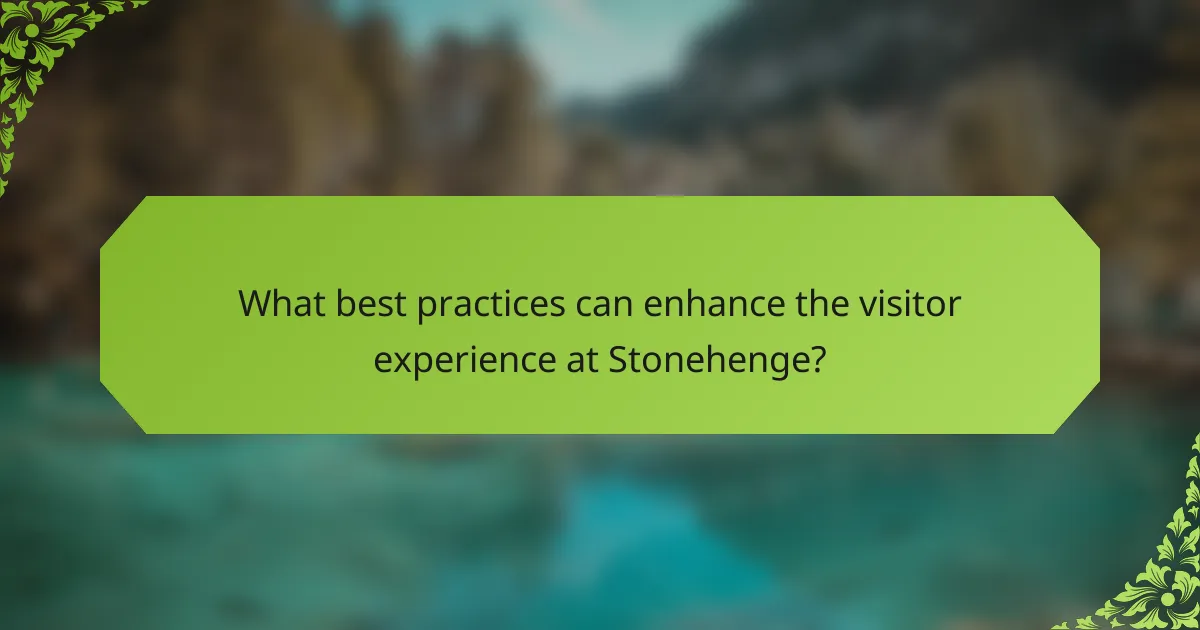
What best practices can enhance the visitor experience at Stonehenge?
Enhancing the visitor experience at Stonehenge involves thoughtful planning and engagement strategies. Key practices include guided tours led by knowledgeable experts, interactive exhibits that explain the site’s history, and improved accessibility features for all visitors. Additionally, incorporating virtual reality experiences can deepen understanding of the archaeological significance. Clear signage and visitor information points enhance navigation and overall satisfaction.
How can guided tours be optimized for different visitor groups?
Guided tours can be optimized for different visitor groups by tailoring content, pacing, and accessibility features. For example, families with children benefit from interactive activities, while academic groups may prefer in-depth historical analyses.
Adjusting tour duration accommodates varying attention spans, ensuring engagement for all. Incorporating multilingual guides enhances accessibility for international visitors. Additionally, offering specialized tours, such as those focused on archaeology or cultural interpretations, caters to specific interests, enriching the overall experience at Stonehenge.
What tips should visitors consider for a more enriching experience?
To enhance your visit to Stonehenge, consider the following tips. Arrive early to avoid crowds and take advantage of the peaceful atmosphere. Engage with the visitor center exhibits to gain insights into the archaeological mysteries and cultural interpretations surrounding the site. Wear comfortable shoes for walking, as the terrain can be uneven. Lastly, check accessibility options in advance to ensure a smooth experience for everyone in your group.
Which resources provide the best information before visiting Stonehenge?
The best resources for information before visiting Stonehenge include official websites, guidebooks, and travel blogs. The English Heritage website provides detailed historical context and visitor information. Guidebooks like “Lonely Planet” offer insights on nearby attractions and practical tips. Travel blogs often share personal experiences and recommendations for a more immersive visit.
